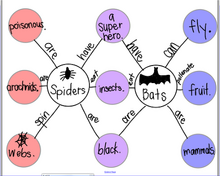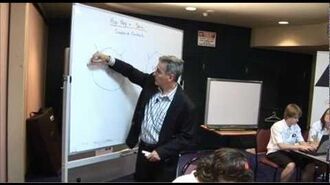
Description[]
The Double Bubble Map is a tool for comparing and contrasting things, including individuals, events, places, ideas and artifacts. It begins with two adjacent central bubbles in which the two ideas are written. Bubbles are then added between the two ideas to capture the common elements between them, while further bubbles are added on the outer extremity of the two original ideas to capture elements that different. It could be thought of as similar to a Venn diagram.
Classroom Practice[]
This type of map could be used help students understand the idea of categories or specific types of descriptors. For example, in the illustration above the students have identified that bats are mammals while spiders are arachnids. This idea of corresponding descriptions could be explored further by looking at categories such as the number of legs, preferred habitats, life-expectancy or relative size. The students have also enhanced the map further by showing the relationship with the descriptor on the connecting lines.

Creating a Double-Bubble Map. - Double Bubble Map
The video to the left demonstrates how Bubble Maps can be used in tandem with Double-Bubble Maps. The Bubble Maps can be used to stimulate and capture the source data from which the similarities and differences between two ideas can be determined through the use of the Double-Bubble Map. It also demonstrates the different media that can be used in the construction of thinking maps, including white-boards, laptops, and pen and paper.
EOTC[]
A key advantage of the thinking-maps concept is that they provide a visual framework for thinking which students can quickly and consistently recall when tasked with carrying out certain types of thinking. This accessibility makes them an ideal add to thinking in contexts where other scaffolds way be unavailable or impractical. For example students engrossed in a rocky shore visit could use their knowledge of a bubble map and double-bubble maps to help them first describe and then compare some of the marine life they encounter.